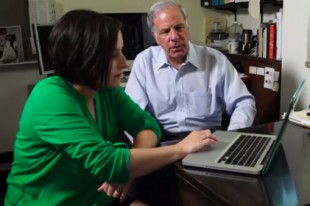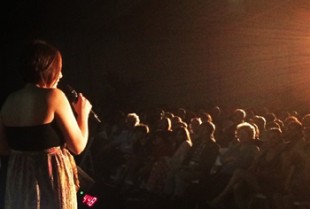Rice student, professor receive 3rd prize at an international illusion competition
With a seemingly simple trick of the eye, Rice University graduate student Kimberley Orsten and Professor of Psychology James Pomerantz took third prize at the Neural Correlate Society’s “Illusion of the Year” contest with an entry called “A Turn in the Road: Metamers, Anti-metamers and False Pop Out.”
Their illusion is a short movie that includes an animation of a picture of three roads, two of which are identical; but people almost always are wrong about which road is the odd one out. It takes advantage of the way the brain can misinterpret information from the eye about color, light and pattern. It mixes two images called “metamers,” which are identical but look different, with two images called “anti-metamers,” which are different but look the same, Orsten said.
This was the first time Orsten and Pomerantz entered the competition, which the Neural Correlate Society described as “a celebration of the ingenuity and creativity of the world’s premier visual illusion research community.” The May 18 competition in St. Pete Beach, Fla., included 50 entries from research institutions around the world. More than 1,000 members of the international visual science community attended the event, and the video of “A Turn in the Road” posted on YouTube has had more than 325,000 views.
“Our illusion shows how humans sometimes struggle to interpret flat images,” Orsten said. “This should not be a big surprise, because humans – like other creatures – evolved to see a 3-D world, not a 2-D one. When we see an irregular, four-sided figure, we try to perceive it as a simpler figure like a rectangle that’s being viewed from an oblique angle. We see 2-D shapes as identical if they could be depicting the identical 3-D object even if their 2-D projections are different. If we hold several quarters in our open palm, they will all look the same even if they are all at odd angles and therefore project varying, elliptical images to our retinas. That tendency gets us into trouble when we judge patterns that are actually 2-D.”
Surprisingly, Orsten and Pomerantz stumbled across the illusion by accident.
“We discovered our illusion while doing research to test our theory of perceptual organization – the ‘Theory of Basic Gestalts,'” Pomerantz said. “The theory’s goal is to determine the fundamental blocks from which our perceptions are built. We were looking at shape pop out, where, for example, a lone ‘X’ simply jumps out at us from a field of ‘Os’ without our having to search for it one item at a time. We discovered some shapes where our viewers saw pop out, but the stimulus that popped out for them was one of the identical background items, not the item that was physically different. We called that ‘false pop out,’ and it led us down a ‘turn in the road.'”
Both Orsten and Pomerantz noted that while people have been delighted by visual tricks for centuries, illusions are also a very important tool of the trade for scientists who study perception.
“As fun as they are to play with, illusions are serious business for visual scientists,” Orsten said. “They are the fingerprints left behind by our perceptual system that provide us essential clues to figure out how perception works.”
Pomerantz noted that this field of study is conducting important work on designing camouflage, robotic systems for performing tasks such as driving cars and accident prevention.
“Research on illusions has implications for our understanding of how the eye and brain let us see and understand our world,” Pomerantz said. “That, in turn, helps us understand how to prevent perceptual errors that can lead to disastrous results, such as car-train collisions. These are often the result of people misperceiving how far away a train is because they misperceive the size of the train, thinking it is smaller than it actually is.”
For more information on the Illusion of the Year competition, visit http://illusionoftheyear.com. The short version of the “Turn in the Road” illusion is here: www.youtube.com/watch?v=k-7fimW5rmU




Leave a Reply